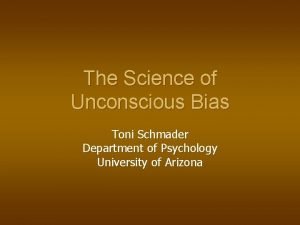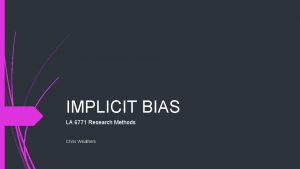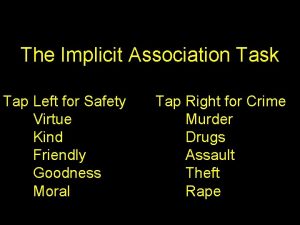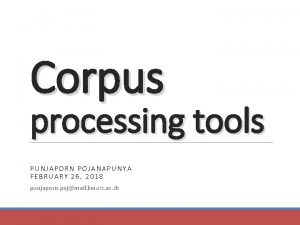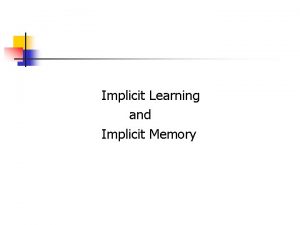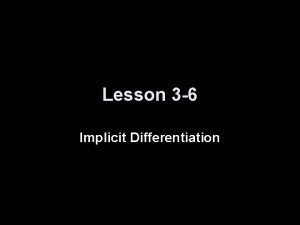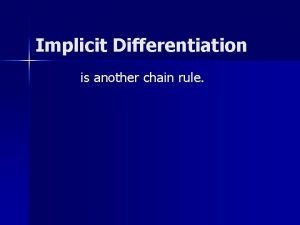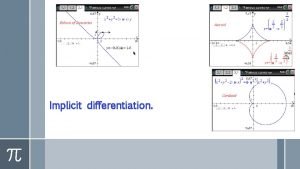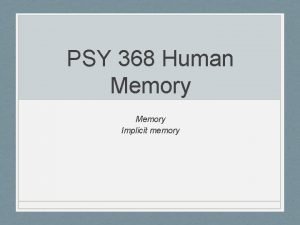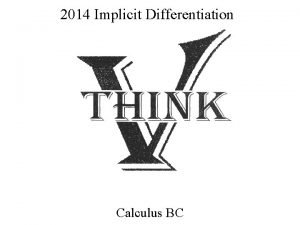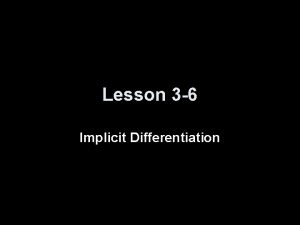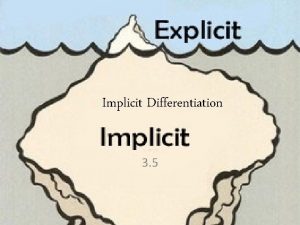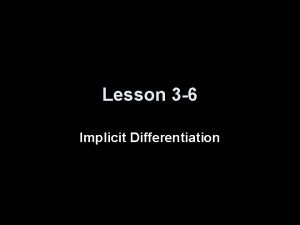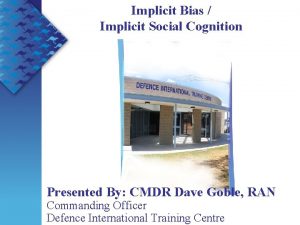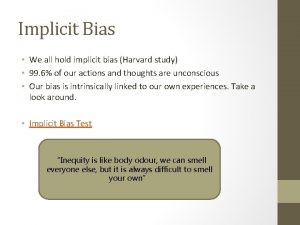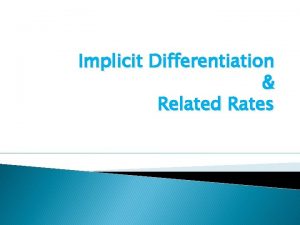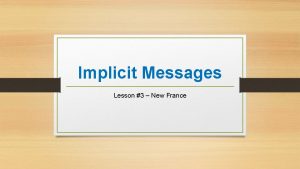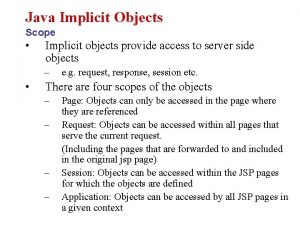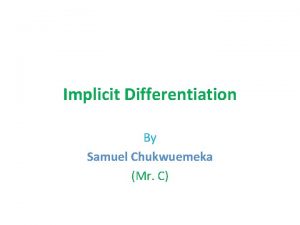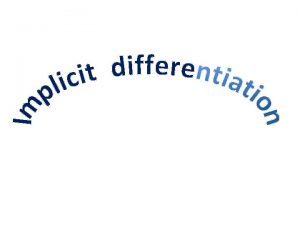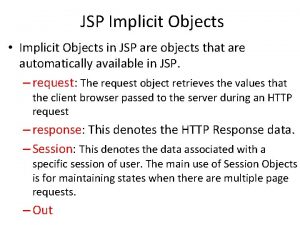Implicit Association Test July 15 2010 Punjaporn Pojanapunya



















- Slides: 19

Implicit Association Test July 15, 2010 Punjaporn Pojanapunya punjaporn. poj@kmutt. ac. th

Speak your mind Can you speak your mind? Do you know your mind? Questionnaire Implicit Association Test (IAT)

Implicit Association Test Assess your unconscious preferences using Implicit Association Test ‘‘a measure of strengths of automatic associations” which examines performance speeds on classification tasks (Greenwald et al. , 2003, p. 197)

Implicit Association Test Concepts - Attributes Concept 1 • words/ pictures link to the concept Concept 2 • words/ pictures link to the concept Attribute 1 • characteristics: link to the attribute Attribute 2 • characteristics: link to the attribute Source: https: //implicit. harvard. edu/implicit/demo/selectatest. html

Implicit Association Test Concepts - Attributes Male • Man • Boy • Father … Female • Woman • Girl • Mother … Science • Biology • Physics • Chemistry … Gender – Science IAT This IAT often reveals a relative link between: Liberal arts & Females Science & Males Source: https: //implicit. harvard. edu/implicit/demo/selectatest. html Liberal Arts • Philosophy • Humanities • Arts …

Implicit Association Test Male Female Science Liberal Arts Man Girl Humanities Biology

Implicit Association Test More IAT: https: //implicit. harvard. edu/implicit/demo/selectatest. html https: //implicit. harvard. edu/implicit/thailand

IAT research Implicit attitudes towards native and non-native speaking teachers Implicit attitudes: IAT Explicit attitudes: preferences and feelings Watson Todd, R. and Pojanapunya, P. , 2009, Implicit attitudes towards native and non-native speaker teachers, System, Vol. 37, No. 1, pp. 23 -33.

IAT research RQs: What are Thai university students’ explicit attitudes towards NESTs and non-NESTs? What are Thai university students’ implicit attitudes towards NESTs and non-NESTs? Is there a relationship between explicit and implicit attitudes towards NESTs and non-NESTs? Is there a relationship between previous learning experience with NESTs and attitudes towards NESTs and non-NESTs?

IAT research Concepts - Attributes NESTs Native Teachers ? This IAT often reveals a relative link between: NESTs & positive ? non-NESTs & negative • Ajarn Michael • Ajarn Julia • Ajarn David … n. NESTs • Ajarn Chokchai • Ajarn Nipaporn • Ajarn Teeradech … Positive • Active • Creative • Enjoyable … Negative • Passive • Derivative • Cheerless …

IAT research: Implicit attitudes (IAT) Concepts & Attributes Names & Characteristics (adjectives) NESTs Ajarn Michael, Ajarn William, Ajarn David, Ajarn Nicholas, Ajarn Sophia, Ajarn Elizabeth, Ajarn Julia Non-NESTs Ajarn Tanapon, Ajarn Teeradech, Ajarn Chokchai, Ajarn Nipaporn, Ajarn Sunisa, Ajarn Wipawan, Ajarn Sureerat Positive Active, creative, enjoyable, flexible, open-minded Negative Passive, derivative, cheerless, rule-bound, dogmatic

IAT research: Explicit attitudes (questionnaire) 1. 2. 3. 4. 5. 6. Have you ever experienced native English speaker teachers? In your educational experience, how much did you like studying English with native and non-native English speaker teachers (NESTs and non-NESTS)? I would want to be taught English by a NEST I would want to be taught English by a non-NEST Suppose that 10 English teachers were recruited. How many of them do you think would be NESTs and non-NESTS? Please rate how warm or cold you feel toward NESTs and non-NESTS? (0 = coldest feelings, 5 = neutral, 10 = warmest feelings)

Try IAT Implicit attitudes towards native and non-native speaking teachers http: //arts. kmutt. ac. th/crs/moodle/instruction. html

Sequence of blocks in the IAT Block No. of trials Function Items assigned to left-key response Items assigned to right-key response 1 20 Practice NEST names Non-NEST names 2 20 Practice Positive adjectives Negative adjectives 3 20 Practice NEST names + positive adjectives Non-NEST names + negative adjectives 4 40 Test NEST names + positive adjectives Non-NEST names + negative adjectives 5 20 Practice Non-NEST names 6 20 Practice Non-NEST names + positive adjectives NEST names + negative adjectives 7 40 Test Non-NEST names + positive adjectives NEST names + negative adjectives

Categories of data: Explicit attitudes Category of data Data source Purpose 1 Experience with NESTs Question 1 of the questionnaire To elicit previous experience with NESTs 2 Preference for NESTs/non-NESTs Question 2 of the questionnaire To directly compare explicit attitudes towards NESTs and non-NESTs 3 Preference for NESTs Question 3 of the questionnaire To elicit explicit attitudes towards NESTs 4 Preference for non-NESTs Question 4 of the questionnaire To elicit explicit attitudes towards non-NESTs 5 Feelings towards NESTs Question 5 of the questionnaire To elicit explicit feelings towards NESTs 6 Feelings towards non-NESTs Question 6 of the questionnaire To elicit explicit feelings towards non-NESTs

Categories of data: Implicit attitudes Category of data Data source Purpose 7 Implicit attitudes 1 Response latencies from Block 4 of the IAT To elicit implicit attitudes with quicker responses suggesting an implicit preference for NESTs 8 Implicit attitudes 2 Response latencies from Block 7 of the IAT To elicit implicit attitudes with quicker responses suggesting an implicit preference for non-NESTs 9 IAT effect Mean response latency in Block 7 minus mean response latency in Block 4 To compare implicit attitudes with positive figures for the IAT effect showing a preference for NESTs, and negative figures showing a preference for non-NESTs 10 IAT interpretation IAT effect divided by average response time To compare implicit attitudes on a 7 point scale

Data analysis RQs: What are Thai university students’ explicit attitudes towards NESTs and non-NESTs? What are Thai university students’ implicit attitudes towards NESTs and non-NESTs? Is there a relationship between explicit and implicit attitudes towards NESTs and non-NESTs? Is there a relationship between previous learning experience with NESTs and attitudes towards NESTs and non-NESTs? Mean, SD, T-test, correlation

IAT & research in So. LA Social Science Smoking: smokers and non-smokers Social imbalance: Isarn and Central Thai Language studies Dictionaries: electronic and paper dictionaries Graded readers: reading in English and reading in Thai

So. LA funding Budget Programmer Minor-cost project funding Proposals • • can be submitted by full-time staff of So. LA can be submitted at any time to the CRS can ask for funding up to a maximum of 5, 000 baht should include the following information: researcher's name, title of research project, concise (1 paragraph) description of the project, and details of budget required Source: http: //arts. kmutt. ac. th/crs/
 Biasnn
Biasnn Implicit bias test
Implicit bias test Implicit association task
Implicit association task Implicit association task
Implicit association task Equality equity
Equality equity Harris burdick another place another time
Harris burdick another place another time Captain tory harris burdick
Captain tory harris burdick July 1-4 1863
July 1-4 1863 Tender definition
Tender definition Diferença entre eclipse lunar e solar
Diferença entre eclipse lunar e solar 2001 july 15
2001 july 15 2003 july 17
2003 july 17 July 30 2009 nasa
July 30 2009 nasa Sources nso july frenchhowell neill technology...
Sources nso july frenchhowell neill technology... May 1775
May 1775 Sylvia plath poppies in july
Sylvia plath poppies in july Miss cuba receives an invitation
Miss cuba receives an invitation Poppies in july
Poppies in july July 10 1856
July 10 1856 Ctdssmap payment schedule july 2021
Ctdssmap payment schedule july 2021
